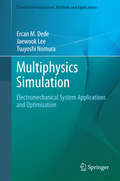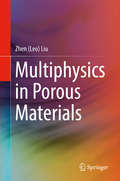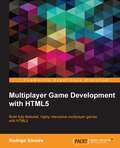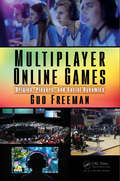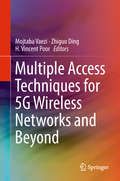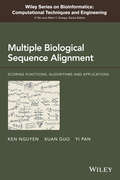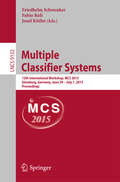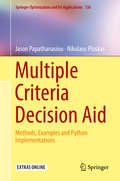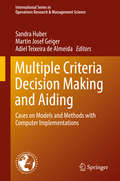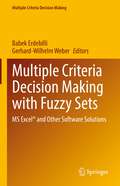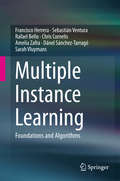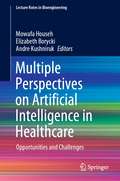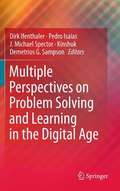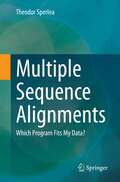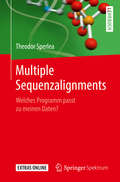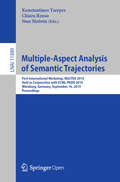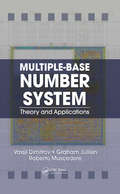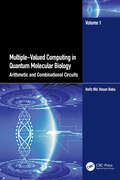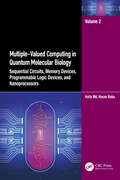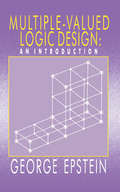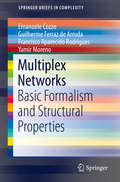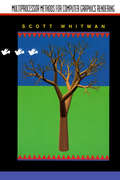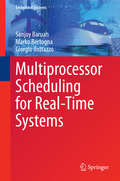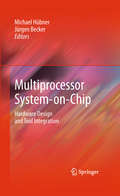- Table View
- List View
Multiphysics Simulation
by Ercan M. Dede Jaewook Lee Tsuyoshi NomuraThis book highlights a unique combination of numerical tools and strategies for handling the challenges of multiphysics simulation, with a specific focus on electromechanical systems as the target application. Features: introduces the concept of design via simulation, along with the role of multiphysics simulation in today's engineering environment; discusses the importance of structural optimization techniques in the design and development of electromechanical systems; provides an overview of the physics commonly involved with electromechanical systems for applications such as electronics, magnetic components, RF components, actuators, and motors; reviews the governing equations for the simulation of related multiphysics problems; outlines relevant (topology and parametric size) optimization methods for electromechanical systems; describes in detail several multiphysics simulation and optimization example studies in both two and three dimensions, with sample numerical code.
Multiphysics in Porous Materials
by Zhen Leo LiuThis book summarizes, defines, and contextualizes multiphysics with an emphasis on porous materials. It covers various essential aspects of multiphysics, from history, definition, and scope to mathematical theories, physical mechanisms, and numerical implementations. The emphasis on porous materials maximizes readers’ understanding as these substances are abundant in nature and a common breeding ground of multiphysical phenomena, especially complicated multiphysics. Dr. Liu’s lucid and easy-to-follow presentation serve as a blueprint on the use of multiphysics as a leading edge technique for computer modeling. The contents are organized to facilitate the transition from familiar, monolithic physics such as heat transfer and pore water movement to state-of-the-art applications involving multiphysics, including poroelasticity, thermohydro-mechanical processes, electrokinetics, electromagnetics, fluid dynamics, fluid structure interaction, and electromagnetomechanics. This volume serves as both a general reference and specific treatise for various scientific and engineering disciplines involving multiphysics simulation and porous materials.
Multiplayer Game Development with HTML5
by Rodrigo SilveiraIf you are a HTML5 game developer who can make basic single-player games and you are now ready to incorporate multiplayer functionality in your games as quickly as possible, then this book is ideal for you.
Multiplayer Online Games: Origins, Players, and Social Dynamics
by Guo FreemanMultiplayer Online Games (MOGs) have become a new genre of "play culture," integrating communication and entertainment in a playful, computer-mediated environment that evolves through user interaction. This book comprehensively reviews the origins, players, and social dynamics of MOGs, as well as six major empirical research methods used in previous works to study MOGs (i.e., observation/ethnography, survey/interviews, content and discourse analysis, experiments, network analysis, and case studies). It concludes that MOGs represent a highly sophisticated, networked, multimedia and multimodal Internet technology, which can construct entertaining, simultaneous, persistent social virtual worlds for gamers. Overall, the book shows that what we can learn from MOGs is how games and gaming, as ubiquitous activities, fit into ordinary life in today’s information society, in the moments where the increased use of media as entertainment, the widespread application of networked information technologies, and participation in new social experiences intersect. <P><P>Key Features: <li>Contains pertinent knowledge about online gaming: its history, technical features, player characteristics, social dynamics, and research methods <li>Sheds light on the potential future of online gaming, and how this would impact every aspect of our everyday lives – socially, culturally, technologically, and economically <li>Asks promising questions based on cutting-edge research in the field of online game design and development
Multiple Access Techniques for 5G Wireless Networks and Beyond
by H. Vincent Poor Mojtaba Vaezi Zhiguo DingThis book presents comprehensive coverage of current and emerging multiple access, random access, and waveform design techniques for 5G wireless networks and beyond. A definitive reference for researchers in these fields, the book describes recent research from academia, industry, and standardization bodies. The book is an all-encompassing treatment of these areas addressing orthogonal multiple access and waveform design, non-orthogonal multiple access (NOMA) via power, code, and other domains, and orthogonal, non-orthogonal, and grant-free random access. The book builds its foundations on state of the art research papers, measurements, and experimental results from a variety of sources.
Multiple Biological Sequence Alignment: Scoring Functions, Algorithms and Evaluation
by Yi Pan Ken Nguyen Xuan GuoCovers the fundamentals and techniques of multiple biological sequence alignment and analysis, and shows readers how to choose the appropriate sequence analysis tools for their tasks This book describes the traditional and modern approaches in biological sequence alignment and homology search. This book contains 11 chapters, with Chapter 1 providing basic information on biological sequences. Next, Chapter 2 contains fundamentals in pair-wise sequence alignment, while Chapters 3 and 4 examine popular existing quantitative models and practical clustering techniques that have been used in multiple sequence alignment. Chapter 5 describes, characterizes and relates many multiple sequence alignment models. Chapter 6 describes how traditionally phylogenetic trees have been constructed, and available sequence knowledge bases can be used to improve the accuracy of reconstructing phylogeny trees. Chapter 7 covers the latest methods developed to improve the run-time efficiency of multiple sequence alignment. Next, Chapter 8 covers several popular existing multiple sequence alignment server and services, and Chapter 9 examines several multiple sequence alignment techniques that have been developed to handle short sequences (reads) produced by the Next Generation Sequencing technique (NSG). Chapter 10 describes a Bioinformatics application using multiple sequence alignment of short reads or whole genomes as input. Lastly, Chapter 11 provides a review of RNA and protein secondary structure prediction using the evolution information inferred from multiple sequence alignments. * Covers the full spectrum of the field, from alignment algorithms to scoring methods, practical techniques, and alignment tools and their evaluations * Describes theories and developments of scoring functions and scoring matrices *Examines phylogeny estimation and large-scale homology search Multiple Biological Sequence Alignment: Scoring Functions, Algorithms and Applications is a reference for researchers, engineers, graduate and post-graduate students in bioinformatics, and system biology and molecular biologists. Ken Nguyen, PhD, is an associate professor at Clayton State University, GA, USA. He received his PhD, MSc and BSc degrees in computer science all from Georgia State University. His research interests are in databases, parallel and distribute computing and bioinformatics. He was a Molecular Basis of Disease fellow at Georgia State and is the recipient of the highest graduate honor at Georgia State, the William M. Suttles Graduate Fellowship. Xuan Guo, PhD, is a postdoctoral associate at Oak Ridge National Lab, USA. He received his PhD degree in computer science from Georgia State University in 2015. His research interests are in bioinformatics, machine leaning, and cloud computing. He is an editorial assistant of International Journal of Bioinformatics Research and Applications. Yi Pan, PhD, is a Regents' Professor of Computer Science and an Interim Associate Dean and Chair of Biology at Georgia State University. He received his BE and ME in computer engineering from Tsinghua University in China and his PhD in computer science from the University of Pittsburgh. Dr. Pan's research interests include parallel and distributed computing, optical networks, wireless networks and bioinformatics. He has published more than 180 journal papers with about 60 papers published in various IEEE/ACM journals. He is co-editor along with Albert Y. Zomaya of the Wiley Series in Bioinformatics.
Multiple Classifier Systems
by Friedhelm Schwenker Fabio Roli Josef KittlerThis book constitutes the refereed proceedings of the 12th International Workshop on Multiple Classifier Systems, MCS 2015, held in Günzburg, Germany, in June/July 2015. The 19 revised papers presented were carefully reviewed and selected from 25 submissions. The papers address issues in multiple classifier systems and ensemble methods, including pattern recognition, machine learning, neural network, data mining and statistics. They are organized in topical sections on theory and algorithms and application and evaluation.
Multiple Criteria Decision Aid: Methods, Examples and Python Implementations (Springer Optimization and Its Applications #136)
by Jason Papathanasiou Nikolaos PloskasMultiple criteria decision aid (MCDA) methods are illustrated in this book through theoretical and computational techniques utilizing Python. Existing methods are presented in detail with a step by step learning approach. Theoretical background is given for TOPSIS, VIKOR, PROMETHEE, SIR, AHP, goal programming, and their variations. Comprehensive numerical examples are also discussed for each method in conjunction with easy to follow Python code. Extensions to multiple criteria decision making algorithms such as fuzzy number theory and group decision making are introduced and implemented through Python as well. Readers will learn how to implement and use each method based on the problem, the available data, the stakeholders involved, and the various requirements needed. Focusing on the practical aspects of the multiple criteria decision making methodologies, this book is designed for researchers, practitioners and advanced graduate students in the applied mathematics, information systems, operations research and business administration disciplines, as well as other engineers and scientists oriented in interdisciplinary research. Readers will greatly benefit from this book by learning and applying various MCDM/A methods. (Adiel Teixeira de Almeida, CDSID-Center for Decision System and Information Development, Universidade Federal de Pernambuco, Recife, Brazil) Promoting the development and application of multicriteria decision aid is essential to ensure more ethical and sustainable decisions. This book is a great contribution to this objective. It is a perfect blend of theory and practice, providing potential users and researchers with the theoretical bases of some of the best-known methods as well as with the computing tools needed to practice, to compare and to put these methods to use. (Jean-Pierre Brans, Vrije Universiteit Brussel, Brussels, Belgium) This book is intended for researchers, practitioners and students alike in decision support who wish to familiarize themselves quickly and efficiently with multicriteria decision aiding algorithms. The proposed approach is original, as it presents a selection of methods from the theory to the practical implementation in Python, including a detailed example. This will certainly facilitate the learning of these techniques, and contribute to their effective dissemination in applications. (Patrick Meyer, IMT Atlantique, Lab-STICC, Univ. Bretagne Loire, Brest, France)
Multiple Criteria Decision Making and Aiding: Cases on Models and Methods with Computer Implementations (International Series in Operations Research & Management Science #274)
by Adiel Teixeira de Almeida Martin Josef Geiger Sandra HuberThis book introduces students on Multiple Criteria Decision Aiding and Making courses to practical, real-world cases. Each case study introduces a problem or situation together with a method, and a description and explanation of a computer application. In this sense each chapter is based on four pillars: the problem, the model building, the methods and their implementation. The book presents and elaborates a rich and comprehensive set of practical problems comprising multiple criteria, including numerous approaches for their solution, for decision support or decision aid. It complements traditional textbooks and lecture material by employing case studies to promote a deeper understanding of the investigated concepts and help students apply these methods to other areas.
Multiple Criteria Decision Making with Fuzzy Sets: MS Excel® and Other Software Solutions (Multiple Criteria Decision Making)
by Gerhard-Wilhelm Weber Babek ErdebilliUsing numerical examples to illustrate their concepts and results, this book examines recently developed fuzzy multi-criteria methods, such as Intuitionistic Fuzzy TOPSIS, Intuitionistic Fuzzy TOPSIS & DEA-AHP, Intuitionistic VIKOR, Pythagorean WASPAS, Pythagorean ENTROPI, Hesitant CBD, Hesitant MABAC, Triangular EDAS, Triangular PROMETHEE, q-Rung Orthopair COPRAS, and Fuzzy Type – 2 ELECTRE. Each chapter covers practical applications in addition to fresh developments and results. Given its structure and scope, the book can be used as a textbook in graduate courses on operations research and industrial engineering. It also offers a valuable resource for scientists working in a range of disciplines that require multi-criteria decision making.
Multiple Instance Learning
by Sebastián Ventura Francisco Herrera Rafael Bello Chris Cornelis Amelia Zafra Dánel Sánchez-Tarragó Sarah VluymansThis book provides a general overview of multiple instance learning (MIL), defining the framework and covering the central paradigms. The authors discuss the most important algorithms for MIL such as classification, regression and clustering. With a focus on classification, a taxonomy is set and the most relevant proposals are specified. Efficient algorithms are developed to discover relevant information when working with uncertainty. Key representative applications are included. This book carries out a study of the key related fields of distance metrics and alternative hypothesis. Chapters examine new and developing aspects of MIL such as data reduction for multi-instance problems and imbalanced MIL data. Class imbalance for multi-instance problems is defined at the bag level, a type of representation that utilizes ambiguity due to the fact that bag labels are available, but the labels of the individual instances are not defined. Additionally, multiple instance multiple label learning is explored. This learning framework introduces flexibility and ambiguity in the object representation providing a natural formulation for representing complicated objects. Thus, an object is represented by a bag of instances and is allowed to have associated multiple class labels simultaneously. This book is suitable for developers and engineers working to apply MIL techniques to solve a variety of real-world problems. It is also useful for researchers or students seeking a thorough overview of MIL literature, methods, and tools.
Multiple Perspectives on Artificial Intelligence in Healthcare: Opportunities and Challenges (Lecture Notes in Bioengineering)
by Mowafa Househ Elizabeth Borycki Andre KushnirukThis book offers a comprehensive yet concise overview of the challenges and opportunities presented by the use of artificial intelligence in healthcare. It does so by approaching the topic from multiple perspectives, e.g. the nursing, consumer, medical practitioner, healthcare manager, and data analyst perspective. It covers human factors research, discusses patient safety issues, and addresses ethical challenges, as well as important policy issues. By reporting on cutting-edge research and hands-on experience, the book offers an insightful reference guide for health information technology professionals, healthcare managers, healthcare practitioners, and patients alike, aiding them in their decision-making processes. It will also benefit students and researchers whose work involves artificial intelligence-related research issues in healthcare.
Multiple Perspectives on Problem Solving and Learning in the Digital Age
by Dirk Ifenthaler J. Michael Spector Kinshuk Pedro Isaias Demetrios G. SampsonThis edited volume with selected expanded papers from CELDA (Cognition and Exploratory Learning in the Digital Age) 2009 (http://www.celda-conf.org/) addresses the main issues concerned with problem solving, evolving learning processes, innovative pedagogies, and technology-based educational applications in the digital age. There have been advances in both cognitive psychology and computing that have affected the educational arena. The convergence of these two disciplines is increasing at a fast pace and affecting academia and professional practice in many ways. Paradigms such as just-in-time learning, constructivism, student-centered learning and collaborative approaches have emerged and are being supported by technological advancements such as simulations, virtual reality and multi-agents systems. These developments have created both opportunities and areas of serious concerns. This volume aims to cover both technological as well as pedagogical issues related to these developments.
Multiple Sequence Alignments: Which Program Fits My Data?
by Theodor SperleaThis book is a practical guide for biologists who use multiple sequence alignments (MSAs) for their data analysis and are looking for a comprehensive overview of the many different programs. Despite their important role in data analysis, there is uncertainty among researchers about exactly how MSA programs work - not to mention how and why the different analyzes lead to different results. Which program is the right one for evaluating my data and how can I ensure that I have drawn all relevant findings from the alignments? This book offers helpful explanations and background information without requiring extensive bioinformatics knowledge and slowly introduces the reader to the topic.In the first part of the book, the possible fields of application as well as the formats that are usually produced by MSA programs are described in detail. The central algorithms as well as the internal processes of the most common MSA programs of the past and the present are also explained in an uncomplicated manner in greater detail. The second part of the book is a detailed, data-based comparison between MSA programs, which is intended to help you decide which program to use for your next alignment.
Multiple Sequenzalignments: Welches Programm passt zu meinen Daten?
by Theodor SperleaDieses Buch ist ein praktischer Ratgeber für Biologinnen und Biologen, die Multiple Sequenzalignments (MSAs) für ihre Datenanalysen verwenden und einen verständlichen Überblick über die vielen verschiedenen Programme suchen. Trotz ihres wichtigen Stellenwertes in der Datenanalyse herrscht Unsicherheit unter den Forschenden wie MSA-Programme genau funktionieren - ganz zu schweigen davon, wie und warum die unterschiedlichen Analysen zu verschiedenen Ergebnissen führen. Welches Programm ist für die Auswertung meiner Daten das richtige und wie kann ich sicherstellen, alle relevanten Erkenntnisse aus den Alignments gezogen zu haben? Dieses Buch bietet hilfreiche Erklärungen und Hintergründe ohne große bioinformatische Vorkenntnisse vorauszusetzen und führt die Leserinnen und Leser langsam in die Thematik ein.Im ersten Teil des Buches werden die möglichen Einsatzfelder wie auch die Formate, die üblicherweise von MSA-Programmen produziert werden, im Detail beschrieben. Ebenso werden auf unkomplizierte Weise die zentralen Algorithmen sowie die inneren Abläufe der gängigsten MSA-Programme der Vergangenheit und der Gegenwart in größerer Detailtiefe erklärt. Den zweiten Teil des Buches bildet ein ausführlicher datenbasierter Vergleich zwischen MSA-Programmen, der als Entscheidungshilfe für die Programmauswahl für dein nächstes Alignment dienen soll.
Multiple-Aspect Analysis of Semantic Trajectories: First International Workshop, MASTER 2019, Held in Conjunction with ECML-PKDD 2019, Würzburg, Germany, September 16, 2019, Proceedings (Lecture Notes in Computer Science #11889)
by Chiara Renso Stan Matwin Konstantinos TserpesThis open access book constitutes the refereed post-conference proceedings of the First International Workshop on Multiple-Aspect Analysis of Semantic Trajectories, MASTER 2019, held in conjunction with the 19th European Conference on Machine Learning and Knowledge Discovery in Databases, ECML PKDD 2019, in Würzburg, Germany, in September 2019.The 8 full papers presented were carefully reviewed and selected from 12 submissions. They represent an interesting mix of techniques to solve recurrent as well as new problems in the semantic trajectory domain, such as data representation models, data management systems, machine learning approaches for anomaly detection, and common pathways identification.
Multiple-Base Number System: Theory and Applications (Circuits and Electrical Engineering)
by Vassil Dimitrov Graham Jullien Roberto MuscedereComputer arithmetic has become so fundamentally embedded into digital design that many engineers are unaware of the many research advances in the area. As a result, they are losing out on emerging opportunities to optimize its use in targeted applications and technologies. In many cases, easily available standard arithmetic hardware might not necessarily be the most efficient implementation strategy. Multiple-Base Number System: Theory and Applications stands apart from the usual books on computer arithmetic with its concentration on the uses and the mathematical operations associated with the recently introduced multiple-base number system (MBNS). The book identifies and explores several diverse and never-before-considered MBNS applications (and their implementation issues) to enhance computation efficiency, specifically in digital signal processing (DSP) and public key cryptography. Despite the recent development and increasing popularity of MBNS as a specialized tool for high-performance calculations in electronic hardware and other fields, no single text has compiled all the crucial, cutting-edge information engineers need to optimize its use. The authors’ main goal was to disseminate the results of extensive design research—including much of their own—to help the widest possible audience of engineers, computer scientists, and mathematicians. Dedicated to helping readers apply discoveries in advanced integrated circuit technologies, this single reference is packed with a wealth of vital content previously scattered throughout limited-circulation technical and mathematical journals and papers—resources generally accessible only to researchers and designers working in highly specialized fields. Leveling the informational playing field, this resource guides readers through an in-depth analysis of theory, architectural techniques, and the latest research on the subject, subsequently laying the groundwork users require to begin applying MBNS.
Multiple-Choice and Free-Response Questions in Preparation for the AP Computer Science Examination
by Leon SchramThe review concludes with a set of tricky questions, also known as snooker questions. A snooker question is a question that a student with good knowledge of a topic, nevertheless gets wrong. Therefore, we have devoted a large chapter for snooker questions. This new chapter covers 15 major topic areas that are tested on the AP Exam and provides two questions for each topic, to assist students with subtle trickiness in questions.
Multiple-Valued Computing in Quantum Molecular Biology: Arithmetic and Combinational Circuits
by Hafiz Md. BabuThis book focuses on the design methodologies of various quantum circuits, DNA circuits, DNA-quantum circuits and quantum-DNA circuits. It considers the merits and challenges of multivalued logic circuits in quantum, DNA, quantum-DNA and DNA-quantum computing. Multiple-Valued Computing in Quantum Molecular Biology: Arithmetic and Combinational Circuits is Volume 1 of a two-volume set. From fundamentals to advanced levels, this book discusses different multiple-valued logic DNA-quantum and quantum-DNA circuits. The text consists of four parts. Part I introduces multiple-valued quantum computing and DNA computing. It contains the basic understanding of multiple-valued quantum computing, multiple-valued DNA computing, multiple-valued quantum-DNA computing and multiple-valued DNA-quantum computing. Part II examines heat calculation, speed calculation, heat transfer, data conversion and data management in multi-valued quantum, DNA, quantum-DNA and DNA-quantum computing. Part III discusses multiple-valued logic operations in quantum and DNA computing such as ternary AND, NAND, OR, NOR, XOR, XNOR and multiple-valued arithmetic operations such as adder, multiplier, divider and more. Quantum-DNA and DNA-quantum multiple-valued arithmetic operations are also explained in this section. Part IV explains multiple-valued quantum and DNA combinational circuits such as multiple-valued DNA-quantum and quantum-DNA multiplexer, demultiplexer, encoder and decoder. This book will be of great help to researchers and students in quantum computing, DNA computing, quantum-DNA computing and DNA-quantum computing researchers.
Multiple-Valued Computing in Quantum Molecular Biology: Sequential Circuits, Memory Devices, Programmable Logic Devices, and Nanoprocessors
by Hafiz Md. BabuThis book mainly focuses on the design methodologies of various quantum circuits, DNA circuits, DNA-quantum circuits, and quantum-DNA circuits. In this text, the author has compiled various design aspects of multiple-valued logic DNA-quantum and quantum-DNA sequential circuits, memory devices, programmable logic devices, and nanoprocessors. Multiple-Valued Computing in Quantum Molecular Biology: Sequential Circuits, Memory Devices, Programmable Logic Devices, and Nanoprocessors is Volume 2 of a two-volume set, and consists of four parts. This book presents various design aspects of multiple-valued logic DNA-quantum and quantum-DNA sequential circuits, memory devices, programmable logic devices, and nanoprocessors. Part I discusses multiple-valued quantum and DNA sequential circuits such as D flip-flop, SR latch, SR flip-flop, JK flip-flop, T flip-flop, shift register, ripple counter, and synchronous counter, which are described, respectively, with the applications and working procedures. After that, multiple-valued quantum-DNA and DNA-quantum sequential circuits such as D flip-flop, SR flip-flop, JK flip-flop, T flip-flop, shift register, ripple counter and synchronous counter circuits are explained with working procedures and architecture. Part II discusses the architecture and design procedure of memory devices such as random access memory (RAM), read-only memory (ROM), programmable read-only memory (PROM), and cache memory, which are sequentially described in multiple-valued quantum, DNA, quantum-DNA, and DNA-quantum computing. In Part III, the author examines the architectures and working principles of programmable logic devices such as programmable logic array (PLA), programmable array logic (PAL), field programmable gate array (FPGA), and complex programmable logic device (CPLD) in multiple-valued quantum, DNA, quantum-DNA, and DNA-quantum computing. Multiple-valued quantum, DNA, quantum-DNA, and DNA-quantum nanoprocessors are designed with algorithms in Part IV. Furthermore, the basic components of ternary nanoprocessors such as T-RAM, ternary instruction register, ternary incrementor circuit, ternary decoder, ternary multiplexer, ternary accumulator in quantum, DNA, quantum-DNA, and DNA-quantum computing are also explained in detail. This book will be of great help to researchers and students in quantum computing, DNA computing, quantum-DNA computing, and DNA-quantum computing.
Multiple-Valued Logic Design: an Introduction
by G EpsteinMultiple-Valued Logic Design: An Introduction explains the theory and applications of this increasingly important subject. Written in a clear and understandable style, the author develops the material in a skillful way. Without using a huge mathematical apparatus, he introduces the subject in a general form that includes the well-known binary logic as a special case. The book is further enhanced by more 200 explanatory diagrams and circuits, hardware and software applications with supporting PASCAL programming, and comprehensive exercises with even-numbered answers for every chapter. Requiring introductory knowledge in Boolean algebra, 2-valued logic, or 2-valued switching theory, Multiple-Valued Logic Design: An Introduction is an ideal book for courses not only in logic design, but also in switching theory, nonclassical logic, and computer arithmetic. Computer scientists, mathematicians, and electronic engineers can also use the book as a basis for research into multiple-valued logic design.
Multiplex Networks: Basic Formalism and Structural Properties (SpringerBriefs in Complexity)
by Emanuele Cozzo Guilherme Ferraz de Arruda Francisco Aparecido Rodrigues Yamir MorenoThis book provides the basis of a formal language and explores its possibilities in the characterization of multiplex networks. Armed with the formalism developed, the authors define structural metrics for multiplex networks. A methodology to generalize monoplex structural metrics to multiplex networks is also presented so that the reader will be able to generalize other metrics of interest in a systematic way. Therefore, this book will serve as a guide for the theoretical development of new multiplex metrics. Furthermore, this Brief describes the spectral properties of these networks in relation to concepts from algebraic graph theory and the theory of matrix polynomials. The text is rounded off by analyzing the different structural transitions present in multiplex systems as well as by a brief overview of some representative dynamical processes. Multiplex Networks will appeal to students, researchers, and professionals within the fields of network science, graph theory, and data science.
Multiprocessor Methods for Computer Graphics Rendering
by Scott WhitmanThis comprehensive work merges two of the hottest topics in computer science: parallel computing and computer graphics. Selected Topics from the Table of Contents: -Overview of Accelerated Rendering Techniques -Overview of Parallel Methods for Image Generation -Issues in Parallel Algorithm Development -Overview of Base Level Implementation -Compari
Multiprocessor Scheduling for Real-Time Systems
by Marko Bertogna Sanjoy Baruah Giorgio ButtazzoThis book provides a comprehensive overview of both theoretical and pragmatic aspects of resource-allocation and scheduling in multiprocessor and multicore hard-real-time systems. The authors derive new, abstract models of real-time tasks that capture accurately the salient features of real application systems that are to be implemented on multiprocessor platforms, and identify rules for mapping application systems onto the most appropriate models. New run-time multiprocessor scheduling algorithms are presented, which are demonstrably better than those currently used, both in terms of run-time efficiency and tractability of off-line analysis. Readers will benefit from a new design and analysis framework for multiprocessor real-time systems, which will translate into a significantly enhanced ability to provide formally verified, safety-critical real-time systems at a significantly lower cost.
Multiprocessor System-on-Chip
by Michael Hübner Jürgen BeckerThe purpose of this book is to evaluate strategies for future system design in multiprocessor system-on-chip (MPSoC) architectures. Both hardware design and integration of new development tools will be discussed. Novel trends in MPSoC design, combined with reconfigurable architectures are a main topic of concern. The main emphasis is on architectures, design-flow, tool-development, applications and system design.
